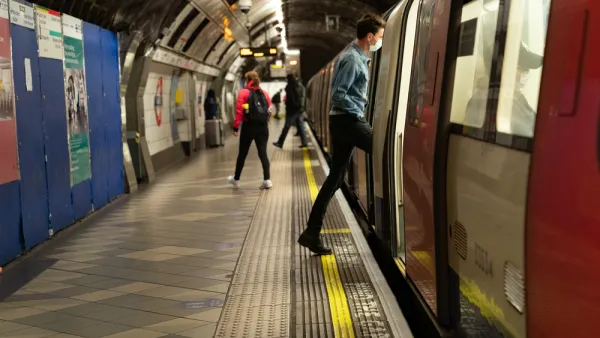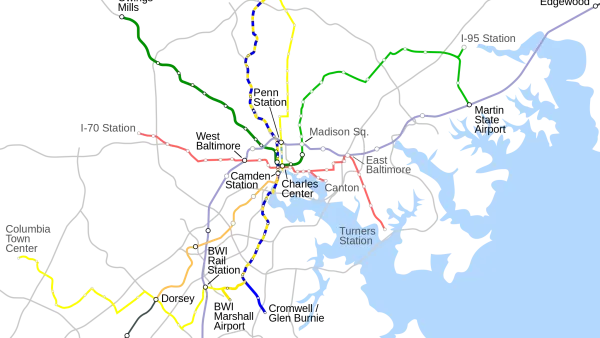Critics claim that public transit projects consistently exceed their budget projections and fail to meet ridership targets, based on old research. New analysis indicates that recent transit services generally perform better than predicted.
Critics frequently claim that public transit projects usually exceed their budget and ridership targets, citing research by Pickrell and Flyvbjerg, whose studies were based on decades-old projects built during the period of declining transit demand. Newer research offers more encouraging news about public transit project cost efficiency and ridership performance.
A study recently published by the Transportation Research Board, Comparative Examination of New Start Light Rail Transit, Light Railway, and Bus Rapid Transit Services Opened from 2000, by Lyndon Henry and Dave Dobbs, compared projected and actual costs, and ridership performance, for 27 major new transit services completed between 2000 and 2011, including 21 light rail transit (LRT) and 5 bus rapid transit (BRT) projects. The findings are encouraging.
That study found that capital costs per mile vary depending on factors such as construction conditions (whether the project involved tunnels and bridges, or required substantial land acquisition) and design factors (such as station quality). For projects with relatively modest infrastructure requirements, LRT had somewhat higher average costs, at $52 million per mile compared with $32 million per mile for BRT. For projects with high infrastructure requirements, the BRT had higher costs, averaging $452 million per mile, compared with $79.8 million per mile for LRT, although this reflects the high costs of two particularly complex projects.
This and other recent studies indicate significant latent demand for high quality public transit: if you build them riders use them. A particularly interesting study is Marlon Boarnet and Doug Houston report, The Exposition Light Rail Line Study: A Before-and-After Study of the Impact of New Light Rail Transit Service. They surveyed 204 households before and after a major new rail line was opened. They found that households residing within a half-mile of the stations reduced their daily household vehicle travel approximately 30% (10 to 12 daily miles) compared with a control group of otherwise similar households located further away.
These studies indicate that new transit services generally perform better than predicted. They demonstrate that new transit services can attract discretionary passengers (people who would otherwise drive), stimulate transit oriented development, reduce per capita vehicle travel, help achieve strategic planning objectives such as reduced traffic congestion, parking costs, accidents and pollution emissions, and stimulate more compact, multi-modal development. Claims that transit projects consistently exceed projected costs and fail to achieve ridership targets are outdated and inaccurate.
For More Information
CTS (2009), Understanding the Impacts of Transitways: The Hiawatha Line: Impacts on Land Use and Residential Housing Value, Center for Transportation Studies, University of Minnesota.
Marlon G. Boarnet and Doug Houston (2013), The Exposition Light Rail Line Study: A Before-and-After Study of the Impact of New Light Rail Transit Service, Price School of Public Policy, University of Southern California for the Haynes Foundation.
Bent Flyvbjerg, Mette Skamris Holm and Søren Buhl (2002), “Underestimating Costs In Public Works Projects: Error or Lie?,”Journal of the American Planning Association, Vol. 68, No. 3, pp. 279-295.
FTA (2008), Predicted And Actual Impacts Of New Starts Projects — 2007 — Capital Cost And Ridership, Office of Planning and Environment, Federal Transit Administration.
Lyndon Henry and Dave Dobbs (2013), Comparative Examination of New Start Light Rail Transit, Light Railway, and Bus Rapid Transit Services Opened from 2000, Sustaining the Metropolis LRT and Streetcars for Super Cities, 12th National Light Rail Conference, Transportation Circular E-C177, Transportation Research Board; summary at http://onlinepubs.trb.org/onlinepubs/conferences/2012/LRT/LHenry.pdf.
Lyndon Henry and Todd Litman (2006), Evaluating New Start Transit Program Performance: Comparing Rail And Bus, Victoria Transport Policy Institute.
Todd Litman (2012), Evaluating Rail Transit Criticism, Victoria Transport Policy Institute.
Todd Litman (2013), Evaluating Public Transit Benefits and Costs, Victoria Transport Policy Institute.
Don Pickrell (1992), “A Desire Named Streetcar: Fantasy and Fact in Rail Transit Planning,” Journal of the American Planning Association, Vol. 58, No. 2, Spring, pp. 158-76.
Gil Tal, Susan Handy and Marlon G. Boarnet (2010), Draft Policy Brief on the Impacts of Transit Access (Distance to Transit) Based on a Review of the Empirical Literature, California Air Resources Board.

National Parks Layoffs Will Cause Communities to Lose Billions
Thousands of essential park workers were laid off this week, just before the busy spring break season.

Retro-silient?: America’s First “Eco-burb,” The Woodlands Turns 50
A master-planned community north of Houston offers lessons on green infrastructure and resilient design, but falls short of its founder’s lofty affordability and walkability goals.

Delivering for America Plan Will Downgrade Mail Service in at Least 49.5 Percent of Zip Codes
Republican and Democrat lawmakers criticize the plan for its disproportionate negative impact on rural communities.

Test News Post 1
This is a summary

Test News Headline 46
Test for the image on the front page.

Balancing Bombs and Butterflies: How the National Guard Protects a Rare Species
The National Guard at Fort Indiantown Gap uses GIS technology and land management strategies to balance military training with conservation efforts, ensuring the survival of the rare eastern regal fritillary butterfly.
Urban Design for Planners 1: Software Tools
This six-course series explores essential urban design concepts using open source software and equips planners with the tools they need to participate fully in the urban design process.
Planning for Universal Design
Learn the tools for implementing Universal Design in planning regulations.
EMC Planning Group, Inc.
Planetizen
Planetizen
Mpact (formerly Rail~Volution)
Great Falls Development Authority, Inc.
HUDs Office of Policy Development and Research
NYU Wagner Graduate School of Public Service






























